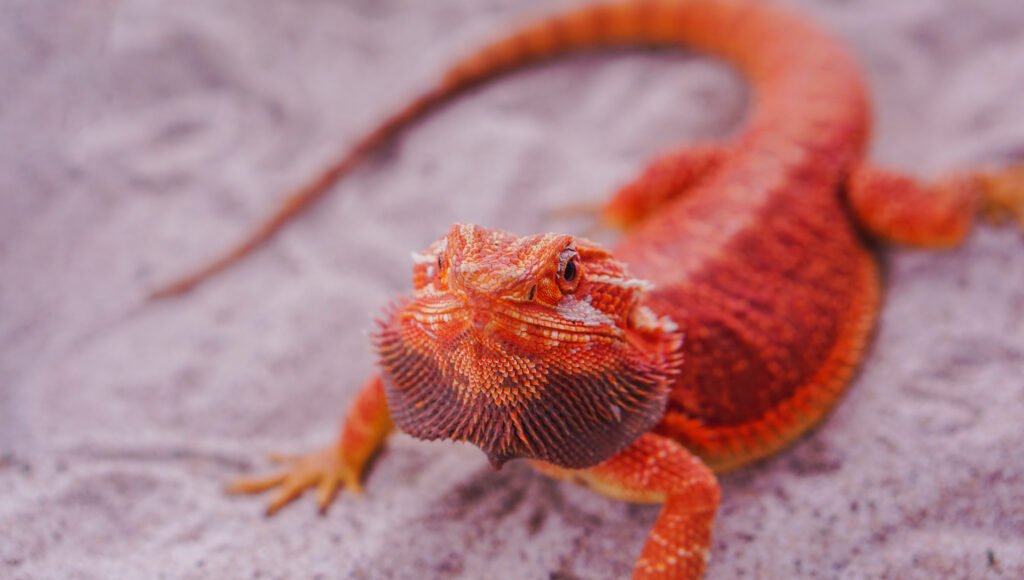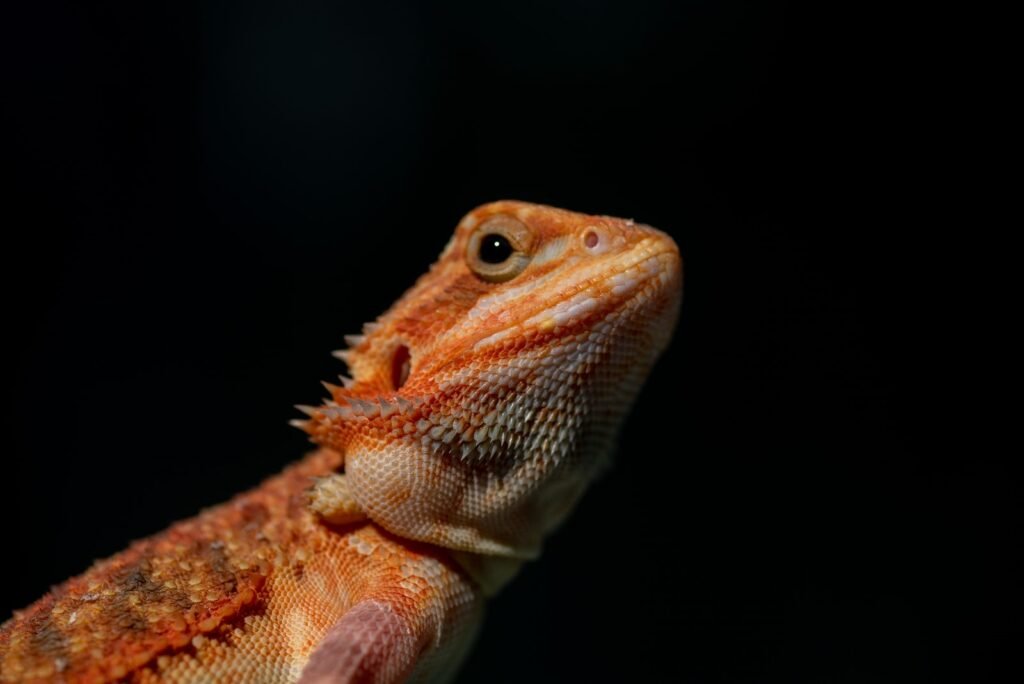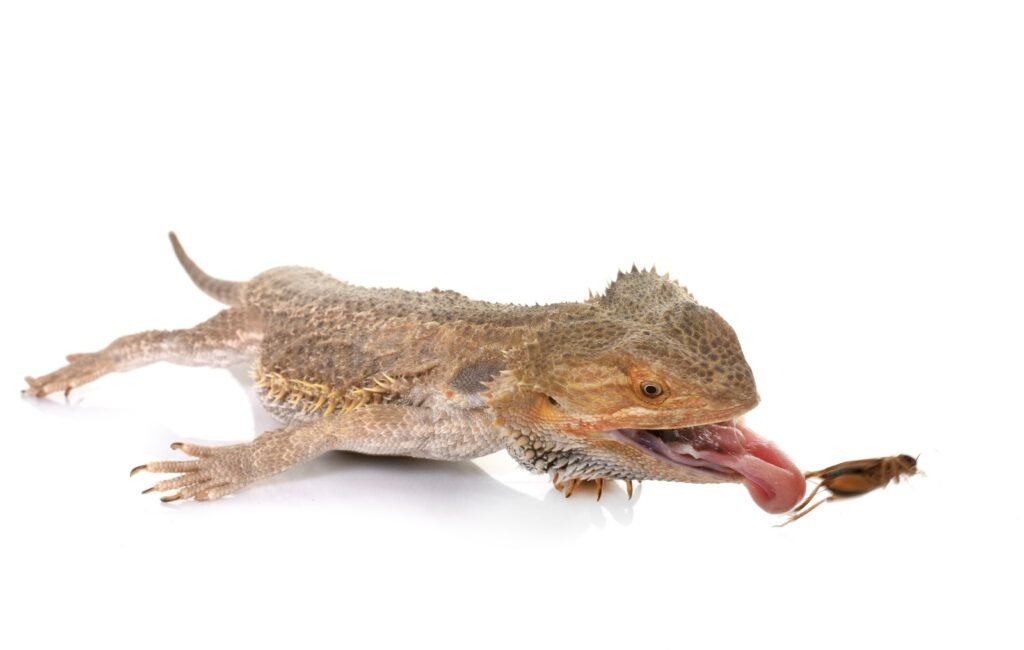
Explore the essentials of bearded dragon nutrition for optimal health. Understand what your pet needs at every stage for a happy and active life with our Bearded Dragon Nutrition Guide.
🍽️The Balanced Bearded Dragon Diet
Creating a balanced diet for your bearded dragon is paramount for their well-being. Here’s how to ensure nutritional adequacy across different life stages, understanding the importance of variety and appropriate supplementation.
Feeding Guidelines Across Life Stages
📌Hatchlings & Juveniles: a diet rich in protein is essential to support their rapid growth, meaning live insects should comprise about 70% of their intake, with 30% being vegetables.
📌Mature Specimens: Your beardie is all grown up. During maturity, the ratio flips—adults require roughly 80% plant-based foods and only 20% protein. Consistency is key; establish a feeding schedule that aligns with their circadian rhythm.
Suitable Foods
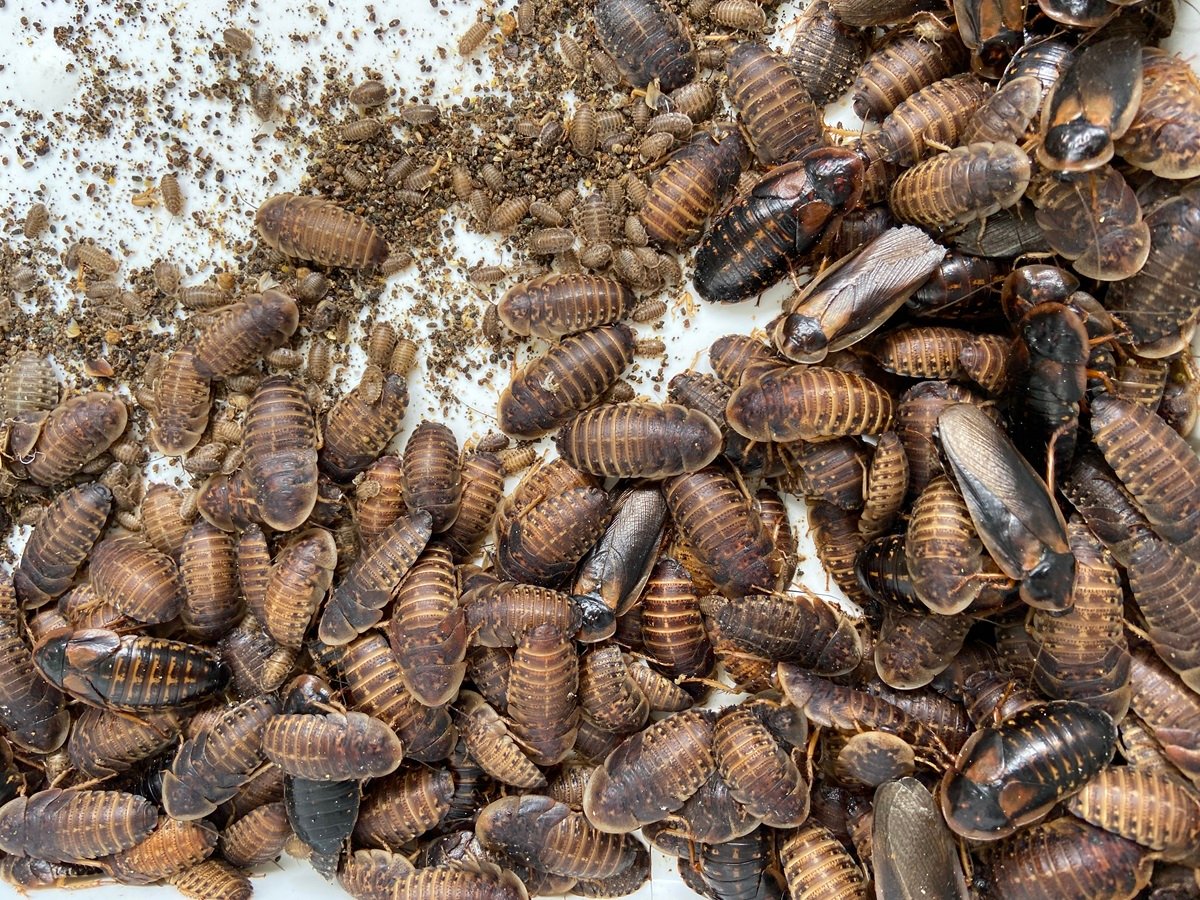
🦗Live Insects: Dubia roaches, crickets, and black soldier fly larvae are staple proteins. Ensure they are gut-loaded for additional nutrition.
🥬Vegetables: Leafy greens like collard, mustard, and turnip greens are excellent daily foods. Bell peppers, squash, and carrots provide variety and nutrients.
🍎Fruits: Offer fruits sparingly; berries, apples, and melon can be occasional treats.
❗Occasional Treats: Fruits should be considered special treats, not dietary staples for bearded dragons. Fruits are high in sugar, which can lead to health issues if consumed excessively. Prioritize Vegetables: Focus on leafy greens, squashes, bell peppers, and other low-sugar, nutrient-rich vegetables as the primary plant-based portion of your bearded dragon’s diet.
🧪Supplementation: Essential Vitamins and Minerals
Calcium and vitamin D3 are non-negotiable for preventing metabolic bone disease. Sprinkle calcium on their meals 4-5 times a week and provide a multivitamin supplement once a week. UVB lighting complements dietary supplementation by aiding in D3 synthesis.
👉Individualized Needs: The frequency of calcium supplementation depends on your bearded dragon’s age, diet, and the quality of your UVB setup. A reptile veterinarian can provide the best guidance.
👉Preventing MBD: Calcium and vitamin D3 are crucial for preventing Metabolic Bone Disease (MBD), a severe health condition caused by calcium deficiency.
👉UVB’s Crucial Role: A high-quality UVB light (T5 HO linear bulb) is equally essential, as it allows bearded dragons to naturally produce vitamin D3, aiding in calcium absorption.
🔎Recognizing Foods That Cause Health Issues
☝️High Phosphorus Foods: Excessive phosphorus binds with calcium, preventing its absorption. This can lead to Metabolic Bone Disease (MBD). Examples include spinach, broccoli, and some commercial diets.
☝️High Oxalate Foods: Oxalates also bind with calcium, making it unavailable to your dragon. While some vegetables contain oxalates, avoid those with extremely high levels, like rhubarb, beet greens, and starfruit.
☝️High Fat Foods: Fatty insects like waxworms or superworms should be offered in strict moderation. Overconsumption can lead to obesity and fatty liver disease, which are serious health risks.
☝️Wild-Caught Insects: These often carry parasites or pesticides harmful to your bearded dragon. Always source insects from reputable suppliers.
☝️“Human Foods”: Processed foods, sugary treats, and most items from our diet are completely unsuitable for bearded dragons and can cause digestive upset or even organ damage.
☝️Unsafe Fruits: Some fruits, like citrus, avocado, or those with large pits can pose choking hazards or contain toxins harmful to bearded dragons.
✅Safe Feeding Practices
Food Prep is Key
✔️Wash Your Hands: Before handling your dragon’s food (or them!), wash your hands to prevent spreading germs.
✔️Fresh and Clean: Always offer fresh veggies and fruits. Remove any uneaten food promptly to prevent spoilage.
✔️Size Matters: Chop foods into pieces smaller than the space between your dragon’s eyes to prevent choking.
🦗Safe and Sound Insect Choices
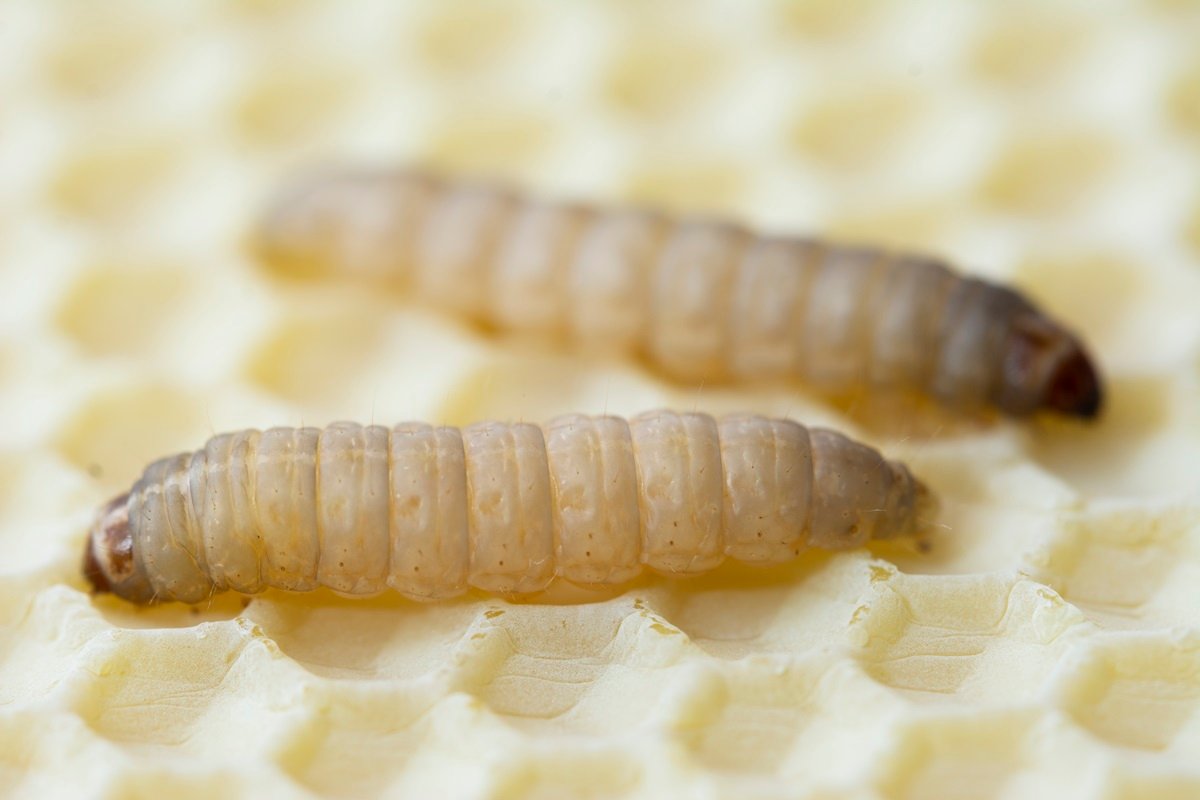
🟢Store-Bought Only: Only feed insects from reputable pet stores or breeders. Never catch bugs from outside – they might have parasites or be covered in pesticides.
🟢Gut-Load Your Feeders: Feed your insects nutritious foods a day or two before giving them to your dragon. This passes the good stuff onto your pet!
🟢Moderation with Treats: Fatty insects like waxworms are like candy – delicious, but only give them sometimes.
🤏Mindful Supplementation
👍Dusting Their Dinner: Lightly sprinkle calcium powder on veggies or insects a few times a week (ask your vet for exact amounts).
👍Vitamin Boost: A multivitamin once a week is usually good, but double-check with your vet.
👍The Sunshine Vitamin: Proper UVB lighting is just as important as supplements; it helps your dragon’s body make its own Vitamin D3!
🧐Always Supervise
📌Prevent Escapes: Feed your dragon in their enclosure to prevent loose crickets from hiding in your house.
📌Watch for Trouble: Make sure your dragon doesn’t eat any substrate (their bedding) along with their food – this can cause blockages.
👩⚕️If in Doubt, Ask the Experts
🔹Unsure About a Food?: Do your research on reliable websites or, even better, ask your reptile vet!
🔹Changes in Appetite: If your dragon suddenly stops eating, a vet visit is a must to rule out any health problems.
🩺Common Health Issues in Bearded Dragons
Bearded dragons, like all pets, can experience a range of health issues. As a pet owner, understanding these potential problems is vital for early detection and treatment.
🦴Metabolic Bone Disease
How to identify Metabolic Bone Disease (MBD): also known as Nutritional Secondary Hyperparathyroidism (NSHP), is a serious health condition commonly found in reptiles, including bearded dragons. It results from a deficiency in calcium, vitamin D3, or improper calcium-to-phosphorus ratio in their diet.
When a bearded dragon lacks adequate calcium or vitamin D3, their body compensates by releasing parathyroid hormone, which stimulates the release of calcium from the bones. Over time, this leads to weakened bones, deformities, and an array of health issues.
- Signs: Look for weakness, twitching muscles, or limbs that appear swollen or rubbery.
- Prevention: Offer a diet rich in calcium and ensure their habitat has appropriate UVB lighting.
- The Role of Calcium: Calcium is crucial for bone health. Without it, your beardie could develop this debilitating condition.
NOTE: Even with the best diet and lighting, some bearded dragons may have underlying health conditions that predispose them to MBD. If you suspect any issues, a reptile vet can help with diagnosis and management.
📏Obesity
Obesity isn’t just about how your bearded dragon looks. It contributes to serious health risks like fatty liver disease, heart problems, and reduced lifespan.
🔸Causes
- Overfeeding: Offering portions that are too large or feeding too frequently is a primary contributor to obesity.
- High-Fat Diet: Excessive reliance on fatty feeder insects (like waxworms or superworms) without balancing them with leaner feeders and vegetables leads to weight gain.
- Lack of Exercise: If your bearded dragon’s enclosure is small and lacks opportunities for climbing and exploring, they’re less likely to burn off the calories they consume.
🔸Weight Management
- Portion Control: Consult reliable resources or your vet for appropriate food portion recommendations based on your dragon’s age and size.
- Dietary Adjustments: Shift the balance towards leaner insects (crickets, dubia roaches, etc.), increase the portion of leafy greens and vegetables, and limit fatty treats.
- Encourage Activity: Provide a larger enclosure with branches, rocks, and other safe climbing structures to promote natural movement and exercise.
- Vet Check-Ups: Your veterinarian can assess your bearded dragon’s weight and provide personalized guidance for weight management if needed.
🔸Important Considerations:
- Natural Fat Storage: Bearded dragons naturally store some fat in their tails. A slightly plump tail base doesn’t necessarily indicate obesity.
- Gradual Changes: Any dietary or exercise adjustments should be made gradually to prevent stress and digestive upset.
Remember, the health of your bearded dragon hinges on a proper diet and adequate UV exposure. Regular vet check-ups are crucial to maintain their well-being.
💊Bearded Dragon Supplements and Hydration
Ensuring your bearded dragon receives proper nutrition and stays hydrated is essential for their overall health and well-being. In this guide, we’ll explore the vital role of nutritional supplements and hydration methods for your dragon’s optimal health.
🦴Vital Supplements: Calcium and Vitamin D3 Requirements
👉Understanding Calcium Needs
- Calcium-Rich Foods: Incorporate calcium-rich foods such as calcium-fortified insects (e.g., crickets, mealworms) and leafy greens (e.g., collard greens, kale) into your dragon’s diet.
- Supplementation Schedule: Provide calcium supplements 3-5 times per week, sprinkling lightly over food or dusting insects before feeding.
👉Importance of Vitamin D3
- UVB Exposure: Ensure your dragon receives adequate UVB exposure from natural sunlight or UVB lighting to synthesize vitamin D3.
- Supplementation Consideration: If UVB exposure is insufficient, consider vitamin D3 supplementation following veterinarian recommendations.
👉Balancing Calcium and Phosphorus
- Calcium-to-Phosphorus Ratio: Aim for a calcium-to-phosphorus ratio of 2:1 in your dragon’s diet to prevent metabolic bone disease (MBD).
- Limiting High-Phosphorus Foods: Avoid feeding high-phosphorus foods like spinach and beet greens excessively, as they can disrupt calcium absorption.
Food Variety Note: Don’t rely solely on calcium-fortified insects. Offer a variety of naturally calcium-rich foods like leafy greens, vegetables, and appropriately-sized insects.
💧Hydration Methods For Adequate Water Intake
✔️Providing Fresh Water
- The Right Dish: Choose a shallow, sturdy dish your dragon can easily access. It should be heavy enough to prevent tipping.
- Cleanliness is Key: Change the water daily and clean the dish regularly to prevent bacteria buildup.
- Location Matters: Place the water dish in a visible spot in their enclosure. Some dragons prefer it near their basking area, others in a cooler part.
- Water Temperature: Room temperature water is ideal. Too cold or too hot water might discourage them from drinking.
✔️Supplementing Hydration Through Diet
💙Moist Foods
- Leafy Greens: Many salad staples, like collard greens, dandelion greens, and turnip greens hold a good amount of moisture.
- Hydrating Veggies: Squashes like butternut or zucchini, as well as bell peppers, contain extra water.
- Occasional Fruits: Melons (watermelon, cantaloupe), berries, and other high-water fruits can be offered in small amounts as treats.
💙Water-rich Insects
- Hornworms: These have a very high moisture content and can be a good choice for slightly dehydrated dragons.
- Silkworms: Contain more moisture than some other feeder insects.
- Dubia Roaches: These feeder insects tend to be a bit juicier than crickets.
❗Important Things to Remember
- Moderation is Key: Too many hydrating foods can cause runny stools. Offer these in addition to their regular diet, not as a replacement.
- Focus on Variety: A balanced diet with a variety of vegetables and insects is always best for their overall health.
- Not a Substitute for Water: Never rely solely on food for hydration. Always provide a constant supply of fresh, clean water in a dish.
✔️Hydration Baths
Bathing your bearded dragon can offer benefits beyond hygiene, but it’s important to do it correctly!
- When They’re Helpful: Baths are most useful for dragons showing signs of dehydration (sunken eyes, lethargy) or having trouble passing stool (constipation).
- Warm, Not Hot: Use lukewarm water that feels comfortably warm on your wrist, like a baby’s bath.
- Shallow Water: Fill the tub or sink so the water reaches your dragon’s belly but doesn’t cover their head.
- Supervised Soaking: Stay with your dragon during the bath, which should last around 10-15 minutes. Many beardies enjoy soaking and might even drink from the bath water!
- Not an Everyday Thing: Most healthy bearded dragons only need a bath every few weeks or even less frequently.
- Shedding Aid: Baths can help loosen stuck sheds, making the process easier for your dragon.
- Cleaning Up Messes: If your dragon gets particularly dirty, a bath to rinse them off is perfectly fine.
- Avoid Over-Bathing: Too frequent bathing can disrupt their natural skin oils and even lead to stress.
- Gentle Cleaning: If needed, use a soft toothbrush to very lightly clean any stuck-on dirt or poop.
- Thorough Drying: After a bath, gently pat your dragon dry with a soft towel to prevent them from getting chilled.
✔️Monitoring Hydration Status
👉Skin Elasticity
- The Idea: Gently pinch a fold of skin on your bearded dragon’s back. If they’re well-hydrated, the skin should quickly snap back into place.
- Not Always Reliable: Bearded dragons naturally have somewhat loose skin. Severe dehydration might make the skin stay tented for longer, but this method isn’t foolproof.
👉Observe Waste
- Normal Waste: Well-hydrated beardies regularly pass both feces and urates (the white, chalky part). Urates should be soft, not hard and dry.
- Infrequent Urination: If your dragon isn’t passing urates regularly, it could be a sign of dehydration. However, some beardies naturally urinate less frequently than others.
👉Better Indicators:
- Overall Alertness: Dehydrated dragons often seem lethargic or have sunken eyes.
- Regular Weight: Sudden weight loss can indicate dehydration.
- Water Intake: The most reliable way to ensure hydration is to observe your dragon drinking from their water dish.
❗Important Note: Hydration assessment is about the whole picture, not just one indicator.
🥄Feeding Strategies and Portion Control
Feeding your bearded dragon a well-balanced diet is crucial for their health and longevity. In this guide, we’ll delve into effective feeding strategies and portion control techniques to ensure your dragon thrives.
🕒Frequency of Feeding
Age Matters
Hatchlings & Juveniles: These young dragons have high energy needs for rapid growth. Offer insects multiple times a day (2-3 feedings are common).
Adults: Once fully grown, most bearded dragons do well with a single feeding per day. Some might prefer smaller, more frequent meals.
Seniors: Older bearded dragons might have reduced appetites and benefit from smaller, more frequent meals.
Meal Schedule
Consistency Wins: Try to feed your dragon at roughly the same time each day. This helps regulate their appetite and digestion.
Light and Daytime: Bearded dragons are diurnal (awake during the day). Aim to feed them earlier in the day to align with their natural rhythm.
Portion Size
Visual Cues: A good rule of thumb is to offer as many insects as your dragon will eat in about a 10-15 minute feeding session.
Body Condition: Observe your dragon’s overall body shape. A slightly rounded belly after a meal is fine, but if they look constantly bloated, portions might be too large.
Age-Based Adjustments: Young dragons naturally need more food relative to their size. Adjust portions as they grow to avoid obesity.
Important Notes
Variety is Key: Offer a variety of insects and vegetables, regardless of feeding frequency.
Individual Differences: Some dragons are naturally bigger eaters than others. Adjust based on your pet’s needs and body condition.
Vet Guidance: If unsure about appropriate feeding amounts, your veterinarian can offer personalized advice.
🔄Variety in Diet
- Nutritional Diversity:
- Complete Nutrition: Different insects and vegetables offer varying levels of protein, fats, vitamins, and minerals. A diverse diet ensures your bearded dragon gets everything they need.
- Gut-Loading Benefits: Feeding your insects a nutritious diet (gut-loading) before offering them to your dragon further enhances the nutritional value your pet receives.
- Rotation Strategy: Rotate food options regularly to prevent dietary imbalances and encourage dietary variety.
🦗Offering Live Prey
- Live Insects: Provide a selection of live insects such as crickets, dubia roaches, and phoenix worms, ensuring they are appropriately sized and gut-loaded for optimal nutrition.
- Feeding Techniques:
- Staple Insects: Establish 2-3 safe, nutritious insects as staples (e.g., crickets, dubia roaches, black soldier fly larvae).
- Rotating Feeders: Supplement the staples with other insects (e.g., silkworms, hornworms, locusts) for additional variety.
- Vegetable Variety: Don’t just stick to one or two veggies! Offer a wide range of leafy greens, squashes, bell peppers, etc.
- Occasional Fruits: Treats like berries, melon, or apples can be offered in small amounts.
⚖️Benefits of Variety
- Prevents Nutritional Deficiencies: Ensures your dragon gets a full spectrum of nutrients.
- Keeps Mealtime Exciting: Prevents boredom and encourages natural foraging behaviors.
- Healthier Dragon: A balanced, varied diet supports overall health and a strong immune system.
🍴Food Variety and Safety Explained
Ensuring a diverse and safe diet is essential for the health and well-being of your bearded dragon. Let’s explore the importance of food variety and safety measures to keep your dragon thriving.
❌Foods to Exclude from Your Bearded Dragon’s Diet
Harmful Vegetables and Fruits:
- Avocado: Contains substances that are toxic to bearded dragons.
- Rhubarb: Extremely toxic and can cause kidney failure.
- Spinach and Beet Greens: High in oxalates, which hinder calcium absorption.
Insect Precautions:
- Fireflies: Can be lethal to bearded dragons due to their toxic chemical content.
- Wild-Caught Insects: Risky due to potential pesticides and parasites.
Unsafe Treats:
- Citrus Fruits: Too acidic and can upset your dragon’s stomach.
- Dairy Products: Bearded dragons cannot digest lactose.
✅Safe Treats For Your Beardie
Fruits and Snacks
- Berries: Offer small quantities of safe fruits like strawberries and blueberries as occasional treats, providing essential vitamins and antioxidants, addressing bearded dragon diet vitamins requirements.
- Leafy Greens: Incorporate leafy greens such as collard greens and dandelion greens into your dragon’s diet as nutritious and safe options for variety.
Occasional Indulgence
- Mealworms: Treat your dragon to occasional mealworms as a protein-rich snack, ensuring they are gut-loaded and offered in moderation to prevent nutritional imbalances.
- Commercial Treats: Consider commercially available bearded dragon treats like freeze-dried insects or vegetable medleys, offering them sparingly as supplementary snacks.
By steering clear of toxic foods and incorporating safe treats into your dragon’s diet, you can provide them with a balanced and enjoyable dining experience while safeguarding their health and vitality.
Bearded dragons make fantastic pets for reptile enthusiasts of all experience levels. With proper care and attention, these captivating creatures can thrive in captivity for many years. We hope this guide serves as a valuable resource on your journey to becoming a knowledgeable and responsible bearded dragon owner.
💚Bearded Dragon Health: Signs and Veterinary Advice
Bearded dragons are hardy creatures, but they’re not invincible. As a bearded dragon owner, recognizing the early signs of illness is crucial for the well-being of your pet. This guide offers an overview of symptoms to watch for and advice on when to seek professional veterinary care.
🚩Identifying Warning Signs
Physical Changes
- Appetite Loss: Sudden disinterest in eating can signal internal issues.
- Stool Alterations: Watch for changes in frequency, color, or consistency in droppings.
- Weight Fluctuations: Unexplained weight loss or gain should prompt concern.
Behavioral Shifts
- Lethargy: Excessive sleepiness or inactivity is a red flag.
- Hiding Behavior: If your dragon is constantly hiding, it may indicate stress or sickness.
- Aggression or Irritability: A sudden change in temperament warrants attention.
Visual Cues
- Skin Condition: Look out for discoloration or unshed skin.
- Eyes and Nose: Discharge or puffiness can be signs of respiratory infections.
❗❗When Immediate Vet Care is Needed for Your Bearded Dragon
Rapid Response Situations
Your bearded dragon can exhibit certain symptoms that necessitate urgent veterinary attention. Being able to identify these can make a significant difference in their health outcomes.
- Respiratory Distress: If your dragon is gasping, breathing with an open mouth, or making wheezing sounds, it may indicate a respiratory infection or obstruction.
- Severe Trauma: Any visible signs of injury, such as wounds, fractures, or bleeding, require emergency care to prevent infection or further damage.
- Neurological Symptoms: Uncoordinated movements, tremors, or paralysis are serious signs that could point to neurological issues.
- Sudden Blindness: If your bearded dragon seems unable to see or is bumping into things, immediate veterinary assistance is needed.
- Gastrointestinal Blockage: Signs of a blockage include a swollen abdomen, straining to defecate, or vomiting.
Critical Behavioral Changes
Sometimes, the need for urgent care is signaled by changes in behavior.
- Drastic Change in Behavior: If your normally active dragon becomes lethargic or unresponsive, it’s time to act quickly.
- Severe Lack of Appetite: While occasional disinterest in food can be normal, a complete refusal to eat for extended periods is a red flag.
Post-Feeding Concerns
Even after regular feedings, certain reactions can alert you to health issues.
- Regurgitation: Repeatedly throwing up food soon after eating is not typical and requires investigation.
- Abnormal Fecal Matter: Persistent diarrhea or unusually hard, dry stools can indicate digestive issues.
Knowing when to seek immediate veterinary attention is crucial in safeguarding the health of your bearded dragon. Always have your vet’s contact information handy and don’t hesitate to call them with any concerns. Remember, your prompt action can save your pet’s life.
🧽Preventive Care and Hygiene Practices
Maintaining your bearded dragon’s health goes beyond addressing illnesses—it involves proactive measures to prevent issues from arising. Here, we’ll delve into essential preventive care and hygiene practices to ensure your dragon’s well-being.
✨Habitat Hygiene
Regular Cage Cleaning
- Spot Cleaning: Remove feces, uneaten food, and shed skin daily to prevent bacterial growth.
- Deep Cleaning: Perform a thorough cage cleaning weekly, removing all substrate, disinfecting surfaces, and replacing bedding.
Monitoring Humidity and Temperature
- Humidity Control: Ensure proper humidity levels to prevent respiratory issues and mold growth.
- Temperature Regulation: Maintain appropriate basking and ambient temperatures to support your dragon’s health.
Enclosure Maintenance
- Inspecting Accessories: Regularly check rocks, branches, and other décor for signs of wear or contamination.
- Substrate Replacement: Replace substrate regularly to prevent bacterial buildup and maintain cleanliness.
Water Quality Management
- Fresh Water Supply: Provide clean, chlorine-free water in a shallow dish for hydration.
- Regular Water Change: Change water daily to prevent bacterial growth and contamination.
💚Preventive Health Measures
Balanced Diet
- Nutritious Meals: Offer a varied diet of live insects, leafy greens, and occasional fruits to meet your dragon’s nutritional needs.
- Supplementation: Ensure proper calcium and vitamin supplementation to prevent deficiencies.
Regular Health Checks
- Physical Examinations: Conduct routine visual inspections for signs of illness or injury.
- Veterinary Visits: Schedule annual check-ups with a reptile veterinarian for comprehensive health assessments.
Environmental Enrichment
- Providing Mental Stimulation: Offer hiding spots, climbing structures, and enrichment activities to promote mental well-being.
- Sunlight Exposure: Allow supervised outdoor time to bask in natural sunlight, benefiting physical and mental health.
Quarantine Procedures
- Isolation Period: Quarantine new reptiles for a minimum of 30 days to monitor for infectious diseases before introducing them to existing pets.
- Separate Enclosure: House quarantined dragons in a separate enclosure with dedicated feeding and cleaning supplies.
By implementing these preventive care and hygiene practices, you can promote a healthy and thriving environment for your beloved bearded dragon. Remember, proactive measures are key to ensuring their long-term well-being.
❓FAQ
Can I feed my bearded dragon exclusively with commercial pellets?
Answer: While commercial pellets can supplement a bearded dragon’s diet, they should not be the sole source of nutrition. Offer a varied diet consisting of live insects, leafy greens, and occasional treats for optimal health.
How often should I offer calcium supplements to my dragon?
Answer: Calcium supplements should be dusted onto insects at every feeding for juvenile dragons, while adult dragons may require supplementation every other feeding to prevent metabolic bone disease (MBD).
Are there any vegetables that I should avoid feeding my dragon?
Answer: Yes, some vegetables contain high levels of oxalates or other harmful compounds. Avoid feeding spinach, rhubarb, and avocado to prevent potential health issues.
How can I tell if my bearded dragon is dehydrated?
Answer: Signs of dehydration include sunken eyes, wrinkled skin, and decreased appetite. Ensure your dragon has access to fresh water and consider offering water-rich foods like cucumbers or watermelon.
Should I offer supplements if my dragon receives natural sunlight?
Answer: Even if your dragon receives natural sunlight, it’s essential to supplement their diet with calcium and vitamin D3. Natural sunlight alone may not provide sufficient levels of these essential nutrients.
For more frequently asked questions, you can check our Bearded Dragon Care FAQs: Everything You Need to Know – it contains more than 25 answered questions!
Substrate, Temperature & Lighting are also important for a healthy beardie friend!

